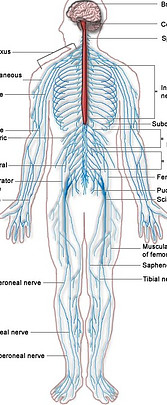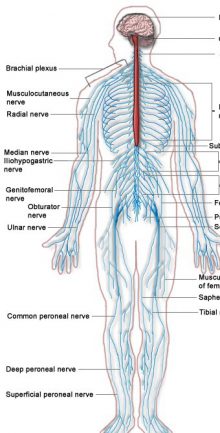
Sensing and acting
The sensory neurons gather input information such as temperature, body position, pain, light, hunger itch and anything that affects the five senses. This information is then transmitted through the nerves to the brain where the information is interpreted. This processing means interpreting what to do with the information. When the brain decides what action should be taken a signal is sent through the nerves to generate action such as contraction of a muscle when your hand touches a hot surface.
Control of all bodily processes
The nervous system not only control sensing and acting, but it also controls all processes in the body. It stimulates the involuntary movement of muscles such as the beating of the heart and controls the bowels. It can stimulate tissues to produce hormones and enzymes
Movement and emotion
The nervous system allows you to move your body through voluntary control of the muscles. The brain which is part of the nervous system is of course extremely important in generating emotions, allowing you to enjoy, love, be angry and sad. The brain enables learning, memorizing, thinking, dreaming, control of behavior and many more.
Peripheral nervous system
The cranial nerves consist of 12 pairs of nerves that pass through small holes at the base of the skull. These nerves carry information and connecting the brain to different parts of the body.
Olfactory Nerve
The olfactory nerve is the shortest pair of cranial nerve and it is the sensory that transmits olfactory (smell) from the nose to the brain.
Optic Nerve
The optic pair of nerves is responsible for conducting visual stimuli from the eye to the brain. It takes the information of the photoreceptors( a receptor that is sensitive to light) to the brain, where later it will be integrated and interpreted. It emerges in the diencephalon.(function)
Oculomotor Nerve
This pair of nerves controls the movement of the eyes and is also responsible for the size of the pupil and it originates in the midbrain.
Trochlear Nerve
The Trochlear (The nerve that controls the superior oblique muscle of the eye, one of the muscles that move the eye (extraocular muscles). This nerve has a motor and somatic functions that are connected to the superior oblique muscle of the eye, being able to make the eyeballs move and rotate. Its nucleus also originates in the mesencephalon (midbrain) as well as the oculomotor nerve.
Trigeminal Nerve
This pair of nerves is the largest of the cranial nerves and its function is to carry sensitive information to the face, to convey information for the chewing process. The sensory fibers convey sensations of touch, it control (sensitive, sensory and motor), The sensory fibers convey sensations of touch, pain, and temperature from the front of the head including the mouth and also from the meninges.( The three membranes that cover the brain and spinal cord)
What is the nervous system?
Abducent
It is also known as the external ocular motor cranial nerves It is a cranial motor pair, responsible for transmitting the motor stimuli to the external rectus muscle of the eye and therefore allowing the eye to move to the opposite side from where we have the nose.
Facial or Intermediate
This pair of cranial nerves consist of several nerve fibers that perform different functions, it allows the facial muscles to create facial expressions and also send signals to the salivary and lachrymal (tear) glands., it also collects taste information through the tongue.
vestibulocochlear Nerve
This sensory cranial nerve is known as the auditory and vestibular nerve, forming the vestibulocochlear. Which is responsible for balance and orientation in space and auditory function.
Glossopharyngeal Nerve
This nerve collects information from the taste buds (tongue) and sensory information from the pharynx. It gives orders to the salivary gland and various neck muscles that help with swallowing. This nerve also monitors blood pressure.
Vagus Nerve
This nerve is also known as pneumogastric. It comes from the medulla oblongata( the continuation of the spinal cord within the skull, forming the lowest part of the brain stem and containing control centers for the heart and lungs).and supplies nerves to the pharynx, esophagus, larynx, trachea, bronchi, heart, stomach and liver., it controls the action of swallowing and also in sending and transmitting signals to our autonomous system, to help and regulate activation and control stress levels.
Accessory Nerve
This nerve is called the spinal nerve. It is a motor nerve. It governs movements of the head and shoulders by supplying the sternocleidomastoid ( neck muscle) and trapezius muscles in the (anterior and posterior) regions of the neck(used to tilt and turn the head and neck, shrug, steady the shoulders, and twist the arms). The spinal nerve also allows us to throw our heads back.
Hypoglossal
This pair of nerves is a motor nerve and is involved in swallowing and speech.
The nervous system organizes, explains, and directs interactions between you and the world around you it is a complex, highly specialized network it affects every aspect of our bodily functions and as you can imagine there is also a great amount of disease that can affect this complex system I will list them and then we will look at the most common ones.
Parkinson disease
Parkinson’s disease is not curable but if caught early medication can be given that can slow down the damage of the cells. Parkinson disease is a progressive disease that affects movement, speech and also causes tremors, especially in the hands.
People may also have stiffness in their limbs and joints and because of this, they move slower than usual. The muscles of the affected person also become much weaker and this may cause their posture may assume a stooping position.
The symptoms of Parkinson’s disease can be managed by medications and therapy.
Multiple sclerosis
At the moment there is no cure for multiple sclerosis but research is ongoing and hopefully, there will be a cure found soon. Multiple sclerosis is often a disabling disease of the central nervous system There are many symptoms associated with ms they range from numbness and tingling to blindness and paralysis.
The progress, severity, and specific symptoms of MS in any one person cannot as yet be predicted, but advances in research and treatment are continuing.
The typical symptoms of MS
The severity of the disease cannot be predicted and varies from person to person one person may have a vision problem and another may have attention and memory issues. At times some symptoms could disappear completely and the person regains lost functions and in another case, the person could have partial or complete paralysis. MS usually affects persons between the ages of 20-50 and affects women more than men at a 2-1 average.
What causes these symptoms?
Ms occurs when the nerve fibers become damaged due to inflammation and break down of the protective insulation surrounding the nerve fibers of the CNS. The fibers are In a whitish insulating sheath which is made up of a mixture of proteins and phospholipids forming around many nerve fibers this sheath is called Myelin, The nerve fibers themselves are also damaged. and the Myelin is destroyed and replaced by scars of hardened patches of tissue. these harden lesions are called plaques and appear in many places within the central nervous system.
The average lifespan of an MS patient
A person with MS may live an average of about seven years less than the general population. however disease complications or other medical conditions like heart condition and stroke which can contribute to life expectancy being shortened. With care and attention to overall health and wellness the reduction of these risk will be lessened There are rare cases of MS that progress rapidly from disease onset and can be fatal
Some information for this post is from the National MS Society
ALS amyotrophic lateral sclerosis
ALS, or amyotrophic lateral sclerosis, is a progressive disease that affects nerve cells in the brain and the spinal cord the word amyotrophic comes from the Greek word which means no muscle nourishment or wastes away. This lack of nourishment to the nerve cells that signal and control the muscles causes the area to degenerates and this leads to scarring or hardening (“sclerosis”) in the region
The eventual loss of the motor neurons due to a progressive degeneration in ALS eventually leads to their death. When the motor neurons die, the brain no longer has the ability to initiate and control muscle movement and any voluntary muscle action is progressively affected, people may lose the ability to speak, eat, move and breathe.
The motor nerves that are affected when you have ALS is the motor neurons that provide voluntary movements and muscle control.
There is no cure or treatments that stop or reverse the effects of ALS and persons usually die 3 ½ years after being diagnosed
Some Information for this post is from the ALS Association.
Here is a link for some easy exercise and stretches for us boomers.
Thank you for reading this post should you have a question or a comment please leave it in the space provided at the end of this post, and please remember to like and share thank you.
http://healthybeautiful.info/health/chair-exercises-help-get-flatter-stomach/
NOTE: This post includes affiliate links, which, if clicked on and a product purchased, I get a small commission (with no increase in cost to you).


